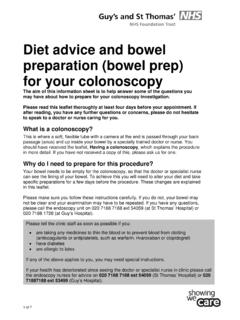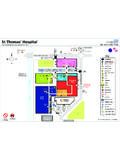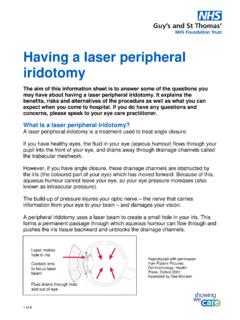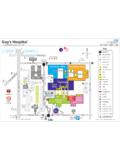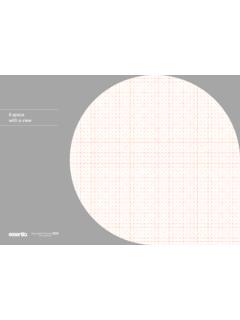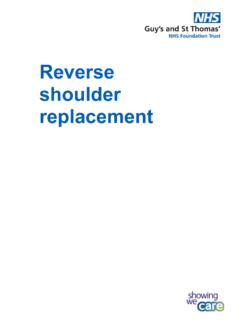Transcription of Hickman line insertion in the interventional radiology ...
1 Hickman line insertion in the interventional radiology department This leaflet explains more about what a Hickman line is, how it is inserted into the body and why your doctor has recommended this for you. If you have any questions or concerns not answered by this leaflet, please contact the interventional radiology (IR) department on 020 7188 5525 for Guy's Hospital, or 020 7188 5477 for St Thomas' Hospital. What is a Hickman line ? A Hickman line is a long, flexible plastic tube that is inserted underneath the chest wall skin and into the large vein draining into the heart (see picture). A Hickman line is a type of tunnelled central line .
2 The space in the middle of the tube is called the lumen. Hickman lines can have one, two or three lumens. These allow different medications to be given at the same time, although the external line diameter is the same. Your interventional Radiologist (IR). Illustration reproduced with permission from Macmillan Cancer Support. doctor will decide how many lumens your line needs. Part of the Hickman line tube remains outside of the skin so that nurses can use the line to give medications or take blood samples. Usually the external part of the line can be hidden by clothes (or bra) so that people will not know that you have a line in place.
3 How is a Hickman line inserted? A Hickman line is inserted by a specialist doctor called an interventional Radiologist (IR). A. Hickman line insertion is a minor surgical procedure, performed in the IR theatre, usually under local anaesthetic ( you will be awake but will feel only minimal discomfort). You need to lie flat for around 30-40 minutes for the procedure. At least two specialist IR nurses, as well as the radiographer and IR doctor will be with you during the procedure to check that you are comfortable and safe. Two small cuts are made 1 of 5. once the skin is numb. One on the chest wall where the line will come out, and a second small cut in the neck or around the collarbone where the line goes into the vein.
4 The second cut will be closed with a single stitch. The procedure is performed using ultrasound (to help identify a suitable large vein) and a special x-ray machine (to check that the line tip is in the right place). These machines make the procedure very safe and avoid the need for large cuts. What are benefits of having a Hickman line ? A Hickman line is a reliable way for nurses and doctors to give intravenous medicines (medicines that need to go directly into a vein), nutrients ( TPN) or to take blood samples. Having a Hickman line means you avoid having a new needle puncture every time you need treatment or a blood test. The Hickman line is meant to remain in place for a long time (months to years) so it can be used throughout your treatment.
5 Doctors recommend the use of a Hickman line for patients who regularly have chemotherapy, long-term antibiotics, total parenteral nutrition (TPN) or difficulty with venous access. Some medications need to be given directly into a large vein rather than small vein in the hand or arm to prevent irritation. Are there any risks of having a Hickman line ? Serious risks and complications of having a Hickman line inserted are very rare. However, as with any procedure, there are some risks and complications which you should be aware of. Infection: The insertion procedure will be carried out in sterile conditions. It is very important that the Hickman line is kept clean, otherwise any infection can get directly into the blood stream.
6 This will require treatment with antibiotics and often the line will need to be removed. Lumen blockage: Your line needs regular care to keep it working normally. If it is not looked after, then one or more of the lumens can become blocked and stop working. If the line gets blocked or breaks and does not work, it will need to be removed and replaced. Scarring: Hickman line insertion requires at least two small (~4 mm) cuts in the skin. These will heal as small scars. The radiologist will discuss the possible risks with you before you have the procedure. Please ask them if you have any concerns or would like any further information.
7 Will I feel any pain? A Hickman line is a minor procedure for most patients. It is usually performed using local anaesthetics to numb the skin in the neck and chest. Because you are awake during the procedure, you can communicate directly with the staff. This also reduces your recovery time so that most patients can eat and drink shortly after the procedure. The line will be ready to use straight away. Additional simple analgesics (like paracetamol) can be used if you are uncomfortable. Are there any alternatives? A Hickman line is a voluntary procedure. Alternatives are to have a temporary line placed every time you have your treatment.
8 This new line needs to be placed and removed each time before you leave hospital. Having new lines placed can be painful (and time consuming). Also 2 of 5. temporary lines might not be suitable for some medications and are not practical if you require infusions over a long period of time. A second alternative is to have a PICC line (peripherally inserted central catheter). PICC lines usually go in the arm, but they are smaller in size and may not be suitable for all medications. PICC lines block more easily than Hickman lines and a PICC may cause the vein in your arm to clot. Please talk to your doctor or nurses if you would like more information about these alternatives.
9 Giving my consent (permission). We want to involve you in decisions about your care and treatment. If you decide to go ahead, you will be asked to sign a consent form. This states that you agree to have the treatment and you understand what it involves. If you would like more information about our consent process, please speak to a member of staff caring for you. Before your procedure We will arrange for you to have some simple blood tests. The IR doctor needs to see a list of all of your medications (tablets, inhalers, creams), so please bring a copy of your current prescription with you. Certain medicines will need to be stopped before your procedure.
10 The IR doctor or nurse will advise you on whether you need to stop any medicines. These medicines can be restarted after your line insertion but the IR doctor or nurse will advise you on this. What happens on the day of your procedure? On the day of your procedure, do not eat or drink anything (except water) for six hours before the procedure. You can drink water up to two hours before the procedure. Eating and drinking before your procedure will cause delays to your procedure. Please arrive 45 minutes before your appointment time to allow sufficient time for preparation. You will need to get changed into a hospital gown and the IR doctor will go through your medications again with you.

